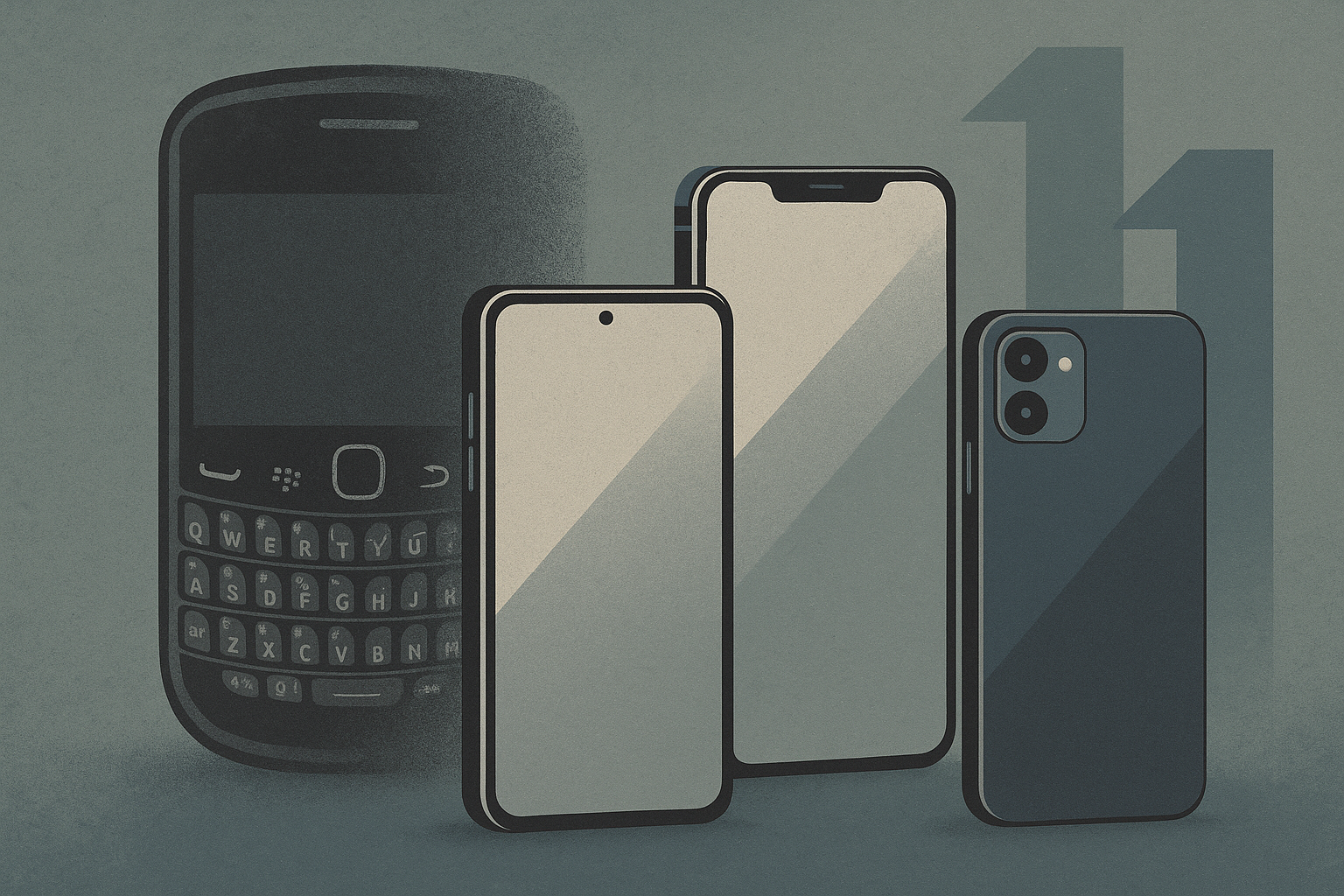Few business stories illustrate the perils of complacency and market disruption as dramatically as BlackBerry’s trajectory. In 2009, BlackBerry commanded nearly 50% of the U.S. smartphone market and over 20% globally, with its devices synonymous with mobile productivity and professional communication. By 2016, its market share had plummeted below 0.1%, and the company had exited hardware manufacturing entirely. This remarkable collapse from industry dominance to irrelevance occurred in less than a decade—a cautionary tale that offers invaluable lessons for business owners, startups, and established brands navigating today’s rapidly evolving markets.
The Meteoric Rise: Building an Empire on Innovation
BlackBerry’s origins trace to 1984 when Mike Lazaridis and Douglas Fregin founded Research In Motion (RIM) in Waterloo, Ontario. Initially focused on wireless technology development, the company developed early two-way pagers and wireless data transmission systems. However, BlackBerry’s breakthrough came in 1999 with the BlackBerry 850—a device combining email, messaging, and phone capabilities in a single handheld unit.
The value proposition was revolutionary for its time. Business professionals could receive and respond to emails instantly from anywhere, dramatically improving productivity and responsiveness. The physical QWERTY keyboard enabled fast, accurate typing that touchscreens couldn’t match. BlackBerry Messenger (BBM) provided secure, instant communication that felt years ahead of traditional SMS. The devices offered weeks of battery life compared to competitors’ days, and enterprise-grade security made them trusted tools for government agencies and Fortune 500 companies.
BlackBerry’s push email technology represented genuine innovation. Rather than users manually checking for new messages, emails arrived on devices within seconds of delivery to servers—a standard feature today but revolutionary in the early 2000s. This “always connected” experience transformed mobile communication patterns and established new expectations for business productivity.
The brand achieved cultural phenomenon status beyond mere market success. BlackBerry devices became status symbols, particularly among business professionals, executives, and government officials. The term “CrackBerry” emerged to describe users’ addiction to constantly checking their devices—a playful acknowledgment of the product’s compelling user experience. President Barack Obama famously refused to give up his BlackBerry upon taking office, requiring special security modifications to allow continued use.
Corporate adoption drove BlackBerry’s growth trajectory. IT departments appreciated the centralized management capabilities, robust security features, and enterprise integration that BlackBerry Enterprise Server provided. Once organizations standardized on BlackBerry, network effects created strong lock-in—colleagues communicated via BBM, corporate applications integrated with BlackBerry infrastructure, and switching costs appeared prohibitively high.
By 2007, BlackBerry had achieved remarkable success by any measure. The company’s stock price had increased over 2,500% in the previous five years. Revenue grew from $294 million in 2003 to $3 billion in 2007. The product commanded premium pricing with strong margins. Market position seemed unassailable, with no serious competitors matching BlackBerry’s enterprise capabilities and security features.
The iPhone Moment: When Everything Changed
On January 9, 2007, Steve Jobs unveiled the iPhone—a device that would fundamentally redefine the smartphone category and ultimately destroy BlackBerry’s business model. Initial reactions from industry observers, including BlackBerry executives, ranged from skeptical to dismissive. The iPhone lacked a physical keyboard, offered inferior battery life, provided no enterprise integration, and cost significantly more than comparable devices.
BlackBerry co-CEO Jim Balsillie famously remarked that the iPhone’s lack of physical keyboard meant it couldn’t appeal to business users. The company’s leadership viewed the iPhone as a consumer toy rather than a serious business tool—a fundamental misreading of market trajectory that would prove catastrophic. This response reflected a common trap for market leaders: evaluating new competitors based on current customer needs rather than anticipating how customer preferences might evolve.
The iPhone represented a paradigm shift in what a smartphone could be. Rather than a communication device with added features, Apple envisioned a pocket computer that happened to include phone capabilities. The multi-touch interface, mobile web browser that displayed full websites, and App Store ecosystem created entirely new use cases and user experiences that BlackBerry’s approach couldn’t match.
Initially, the iPhone’s limitations appeared to validate BlackBerry’s dismissive stance. Corporate IT departments rejected iPhones due to inadequate security and management capabilities. Battery life frustrated users accustomed to BlackBerry’s multi-day endurance. Typing on glass screens felt inferior to physical keyboards. Sales to enterprise customers remained strong, suggesting BlackBerry’s core market was protected.
However, a subtle but profound shift was occurring. Employees began purchasing iPhones personally, then pressuring IT departments to support them for work use. This “consumerization of IT” inverted the traditional top-down enterprise adoption pattern. Instead of organizations dictating technology choices to employees, employees began demanding that organizations support their preferred devices. BlackBerry had optimized for IT department priorities—security, manageability, control—while Apple optimized for end-user experience. As power dynamics shifted, this proved the wrong optimization.
The App Store, launched in July 2008, accelerated the iPhone’s advantages. Third-party developers created applications far exceeding anything available on BlackBerry. Games, productivity tools, social media applications, and countless other categories flourished on iOS while BlackBerry’s app ecosystem stagnated. The platform attracted developer attention because of its large consumer base and Apple’s developer-friendly tools, creating positive feedback loops that further amplified the iPhone’s advantages.
Android’s emergence in 2008 compounded BlackBerry’s challenges. Google’s open-source mobile operating system enabled multiple manufacturers to produce touchscreen smartphones with capabilities rivaling the iPhone. The combination of iOS and Android created a two-platform ecosystem that increasingly defined the smartphone category, with BlackBerry relegated to a shrinking niche.
Strategic Missteps: The Decisions That Sealed BlackBerry’s Fate
BlackBerry’s decline resulted not from a single catastrophic error but from a series of strategic missteps that compounded over time. Understanding these decisions provides valuable lessons for any business facing market disruption.
The first critical error involved underestimating the importance of user experience. BlackBerry prioritized security, battery life, and corporate manageability—legitimate engineering achievements valued by IT departments. However, these priorities came at the cost of user interface innovation, application ecosystems, and the delightful user experiences that Apple emphasized. When the consumerization of IT shifted decision-making power from IT departments to end users, BlackBerry’s optimization for the wrong customer segment proved fatal.
The company’s response to touchscreen interfaces illustrated this user experience blindness. Rather than embracing new interaction paradigms, BlackBerry released devices like the Storm—a touchscreen phone with a physical clicking mechanism that attempted to simulate button presses. This compromise satisfied neither touchscreen enthusiasts nor physical keyboard loyalists, exemplifying BlackBerry’s tendency to split differences rather than making bold choices.
BlackBerry’s platform strategy represented another crucial failure. While Apple and Google invested heavily in developer tools, APIs, and ecosystem development, BlackBerry treated third-party developers as afterthoughts. The company’s development tools were notoriously difficult to use, documentation was poor, and platform capabilities lagged far behind iOS and Android. This ensured that when developers created applications, they targeted iOS and Android first—if BlackBerry versions appeared at all, they came much later with reduced functionality.
The company’s organizational culture contributed significantly to its decline. BlackBerry had succeeded through engineering excellence, particularly in areas like radio frequency technology, battery optimization, and secure communication protocols. This engineering-centric culture struggled to adapt when competitive advantages shifted to software, user experience, and ecosystem development. The dual-CEO structure—with Mike Lazaridis focused on technology and Jim Balsillie focused on business—created leadership ambiguity precisely when decisive strategic direction was most needed.
Product strategy became increasingly reactive rather than visionary. BlackBerry’s PlayBook tablet, released in 2011, exemplified this reactive approach. Rushed to market without email functionality—on a BlackBerry device—the product failed spectacularly. The tablet attempted to respond to the iPad’s success but lacked the software ecosystem, user experience refinement, or compelling value proposition to compete effectively.
The company’s timing on key strategic pivots proved consistently wrong. BlackBerry 10, the company’s redesigned operating system intended to compete with iOS and Android, launched in January 2013—nearly six years after the iPhone’s introduction. By this point, iOS and Android had matured significantly, established vast application libraries, and captured developer mindshare. BlackBerry 10 offered a competent operating system but arrived far too late to recapture lost market share.
Perhaps most fundamentally, BlackBerry failed to recognize that its core business was dying quickly enough to warrant radical strategic shifts. The company’s financial success through 2010 masked underlying market dynamics that were rapidly eroding its position. Revenue and subscriber growth created illusions of health while market share—the more important long-term indicator—was collapsing. This lag between financial performance and strategic reality enabled complacency when aggressive adaptation was essential.
The Consumer vs. Enterprise Miscalculation
A central thread running through BlackBerry’s decline involves the company’s persistent belief that enterprise customers represented a defensible moat against consumer-focused competitors. This assumption proved catastrophically wrong, illustrating important lessons about market dynamics and customer power.
BlackBerry correctly identified that enterprises valued security, manageability, and integration—areas where the company maintained technical advantages over early iPhones and Android devices. Corporate CIOs appreciated BlackBerry Enterprise Server’s centralized control over device policies, the ability to remotely wipe lost devices, and the secure communication architecture that protected sensitive business information.
However, this enterprise focus created blind spots about changing power dynamics. Historically, corporations dictated technology choices to employees, who accepted these decisions as employment conditions. The iPhone disrupted this model by creating consumer demand so strong that employees pressured employers to accommodate their device preferences. When executives asked IT departments to support their personal iPhones, refusing became politically difficult. Once exception processes existed for executives, broader employee populations demanded equal access.
The “Bring Your Own Device” (BYOD) movement fundamentally undermined BlackBerry’s enterprise strategy. Rather than corporations purchasing devices for employees, employees began purchasing their own smartphones and expecting corporate systems to support them. This shift transferred purchasing power from centralized IT departments (BlackBerry’s customer) to individual employees (Apple and Google’s customers). BlackBerry had optimized for the wrong buyer in a market where buyer identity was fundamentally changing.
Moreover, as mobile device management (MDM) solutions emerged enabling enterprises to secure and manage iOS and Android devices, BlackBerry’s security advantages eroded. Third-party vendors like MobileIron and AirWatch provided enterprise security and management capabilities across platforms, eliminating BlackBerry’s technical moat. By 2013, organizations could securely deploy iPhones and Android devices with management capabilities approaching BlackBerry’s traditional advantages.
The consumer market dynamics also worked against BlackBerry. While enterprise sales cycles involve lengthy evaluations and bulk purchases, consumer markets reward rapid innovation and constant improvement. Apple and Google could iterate quickly based on consumer feedback, while BlackBerry’s enterprise focus meant slower product cycles optimized for stability over innovation. This pace differential meant iOS and Android continuously improved while BlackBerry’s feature development stagnated.
Modern Lessons: What Today’s Businesses Must Learn
BlackBerry’s collapse offers essential lessons for modern businesses navigating technological disruption, changing customer preferences, and competitive threats. These principles apply regardless of industry or company size.
Lesson 1: Market share matters more than current profitability. BlackBerry remained financially successful through 2010 despite plummeting market share. Revenue growth and strong margins created illusions of health while strategic position deteriorated rapidly. Today’s business owners must monitor market share and competitive position as carefully as financial metrics, recognizing that profitability often lags behind underlying strategic reality.
Lesson 2: Optimize for end users, not gatekeepers. BlackBerry optimized for IT departments while Apple optimized for end users. When power dynamics shifted, BlackBerry’s advantages became irrelevant. Modern B2B companies must ensure their products delight actual users, not just satisfy procurement departments or technical buyers. User experience can’t be sacrificed for features that please buyers who don’t actually use products.
Lesson 3: Disruption often comes from different value propositions. The iPhone didn’t beat BlackBerry at BlackBerry’s game—it changed the game entirely. The iPhone sacrificed battery life, keyboard superiority, and enterprise features to deliver superior web browsing, applications, and user experience. Companies facing disruption must recognize that competitors may succeed by redefining what customers should value rather than competing on existing dimensions.
Lesson 4: Platform and ecosystem advantages compound over time. BlackBerry treated third-party developers as afterthoughts while Apple and Google made ecosystem development central strategies. Application availability became the iPhone’s and Android’s most powerful competitive advantage—one that grew stronger over time through positive feedback loops. Modern businesses must consider platform dynamics and ecosystem effects, particularly in technology markets.
Lesson 5: Engineering excellence without user-centered design fails. BlackBerry’s engineering was genuinely impressive—radio frequency optimization, battery management, and security architecture all represented technical achievements. However, these accomplishments didn’t translate to compelling user experiences. Excellence in isolated technical dimensions means little if overall user experience disappoints. Modern product development must balance engineering capabilities with design thinking and user experience focus.
Lesson 6: Success breeds dangerous complacency. BlackBerry’s past success created organizational antibodies against change. The company’s culture, processes, and mental models all optimized for the business that had succeeded historically rather than the business needed for future success. Modern organizations must actively fight complacency, particularly during periods of success when the temptation to maintain current approaches feels strongest.
Lesson 7: Financial success can mask strategic failure. BlackBerry’s strong financial performance through 2010 obscured existential threats. Revenue growth, profit margins, and subscriber additions all suggested health while market share was collapsing. Modern businesses must develop metrics capturing long-term strategic position, not just short-term financial performance. Leading indicators like customer satisfaction, brand perception, and competitive position often reveal problems before financial statements do.
Lesson 8: Timing matters enormously in strategic pivots. BlackBerry 10 arrived years too late to change competitive dynamics. The company needed bold moves in 2008-2009, not 2013. Recognizing when your core business faces existential threats and acting decisively despite current success represents one of leadership’s hardest challenges. Waiting for definitive proof of disruption means acting too late.
Lesson 9: Corporate culture must evolve with market demands. BlackBerry’s engineering culture served the company brilliantly during its rise but became a liability when competitive advantages shifted to design, software, and ecosystems. Organizations must periodically assess whether their culture, values, and operating models remain appropriate for current market conditions. Cultural evolution feels threatening to organizational identity but often determines survival.
Lesson 10: Founder-led companies face unique succession challenges. BlackBerry’s dual-CEO structure and founder leadership contributed to strategic rigidity. The founders’ deep expertise in wireless technology and historical success created conviction that proved resistant to contradicting evidence. Modern founder-led companies must develop mechanisms for challenging leadership assumptions and ensuring that historical success doesn’t prevent necessary adaptation.
The Second Act: BlackBerry’s Transformation
While BlackBerry failed as a smartphone manufacturer, the company’s story didn’t end with hardware exit. Under CEO John Chen, appointed in 2013, BlackBerry pivoted dramatically—abandoning smartphone manufacturing and focusing on software, security services, and automotive technology. This transformation offers additional lessons about strategic repositioning and leveraging existing capabilities in new markets.
BlackBerry recognized that while its consumer and enterprise smartphone businesses were dying, the company possessed valuable assets: security expertise, reputation for reliability, patent portfolio, and relationships with automotive and enterprise customers. Rather than fighting unwinnable battles against Apple and Google in smartphones, BlackBerry repositioned around markets where these assets provided competitive advantages.
The company’s QNX operating system, originally acquired in 2010, became central to this transformation. QNX powers embedded systems in automobiles, medical devices, industrial equipment, and other mission-critical applications where reliability and security matter more than user interface flexibility. BlackBerry expanded this business aggressively, with QNX now running in over 195 million vehicles worldwide.
BlackBerry’s enterprise software strategy focused on security, mobile device management, and secure communications—areas aligned with the company’s reputation and expertise. Products like BlackBerry Unified Endpoint Manager, BlackBerry Dynamics, and BlackBerry Spark provide security and management capabilities across devices and operating systems. Rather than competing with Apple and Google in consumer devices, BlackBerry became a provider of security software that works across platforms.
The company’s patent portfolio generated significant revenue through licensing agreements with smartphone manufacturers who use BlackBerry’s intellectual property. This transformed past innovation into ongoing revenue streams without requiring continued leadership in smartphone development.
This transformation demonstrates that even catastrophic strategic failures don’t necessarily mean organizational death. Companies can sometimes pivot to adjacent markets where existing capabilities provide advantages, even after losing core businesses. However, such transformations require honest assessment of competitive position, willingness to abandon losing battles, and clear vision of where existing assets create value in different contexts.
BlackBerry’s second act offers important lessons: failed strategies can sometimes be salvaged through radical repositioning; companies should identify what capabilities genuinely differentiate them rather than persisting in markets where they lack advantages; and letting go of past identity—even when that identity defined the company historically—sometimes represents the only path to survival.
Implications for Startups and Small Businesses
BlackBerry’s story contains lessons particularly relevant for startups and small businesses navigating competitive markets and pursuing growth.
Speed and agility represent crucial advantages over established competitors. BlackBerry’s organizational structure, decision-making processes, and cultural inertia prevented rapid adaptation when markets shifted. Startups and small businesses should recognize that their ability to move quickly and experiment boldly provides competitive advantages against larger, more established competitors. However, as organizations grow, they must actively preserve agility rather than assuming it persists naturally.
Customer obsession beats product obsession. BlackBerry fell in love with its technology—keyboards, battery life, security architecture—rather than continuously discovering and adapting to evolving customer needs. Modern businesses must maintain relentless focus on customer problems, preferences, and experiences rather than becoming attached to particular products or technologies. The product serves customer needs; when those needs change, products must evolve regardless of organizational attachment to current approaches.
Building ecosystems and platform effects creates sustainable advantages. BlackBerry treated its platform as a device feature rather than recognizing platform effects as primary sources of competitive advantage. Startups should consider how their products might become platforms enabling third-party innovation, network effects connecting users, or ecosystems creating lock-in through complementary offerings. These dynamics create compounding advantages that simple product features cannot match.
Market positioning must evolve as markets mature. BlackBerry’s enterprise positioning made sense during its growth phase but became liability as market dynamics shifted. Startups often begin by serving specific niches but must strategically evolve positioning as markets mature, customer preferences change, or new segments emerge. The positioning appropriate for early growth phases may require fundamental revision for later stages.
Financial discipline during good times enables survival during bad times. BlackBerry’s profitability through 2010 provided resources for attempted turnaround, though ultimately unsuccessful. Startups often face pressure to grow at any cost, sacrificing profitability for market share. BlackBerry’s experience suggests that maintaining some financial discipline—even during growth phases—provides crucial flexibility when conditions deteriorate or pivots become necessary.
Conclusion: Vigilance, Humility, and Adaptation
BlackBerry’s rise and fall illustrates business’s harsh realities: market leadership provides no permanent protection, past success offers no guarantee of future relevance, and complacency invites destruction regardless of how dominant your position appears. The company that once defined mobile productivity and commanded premium pricing became a cautionary tale studied in business schools—a transition from industry leader to historical footnote that occurred with shocking speed.
For business owners, entrepreneurs, and corporate leaders, BlackBerry’s story demands uncomfortable reflection. Are we optimizing for current customers or future market realities? Do we truly understand why customers choose our products, or have we constructed convenient narratives that make us feel secure? When facing potential disruption, do we respond with honest assessment and bold adaptation, or do we dismiss threats as irrelevant to our unique circumstances?
The businesses that survive and thrive amid constant technological change share certain characteristics: intellectual humility that acknowledges they might be wrong; relentless customer focus that adapts to changing needs rather than defending current offerings; willingness to cannibalize successful products before competitors do; platform thinking that considers ecosystems and network effects; and organizational cultures that embrace change even when current approaches are succeeding.
BlackBerry’s executives weren’t stupid, lazy, or incompetent. They were smart, hard-working leaders who had built one of the technology industry’s great success stories. Their failure wasn’t one of intelligence or effort but of perspective, humility, and adaptation. They couldn’t believe that advantages that had dominated markets for years could erode so quickly. They couldn’t imagine that consumers would drive enterprise technology decisions. They couldn’t accept that their engineering excellence was becoming irrelevant to increasingly important competitive dimensions.
The lesson isn’t that any specific company or product is doomed—it’s that vigilance, humility, and willingness to adapt must persist regardless of current success. The market share you command today, the customers who seem loyal, the competitive advantages that appear unassailable—all can disappear faster than seems possible. BlackBerry controlled half the U.S. smartphone market in 2009 and effectively zero by 2016. Seven years from dominance to irrelevance.
Your business, regardless of industry or current success, faces similar dynamics. Technologies change. Customer preferences evolve. Competitors innovate. Market structures transform. The only certainty is continued change. The question isn’t whether your business will face disruption—it’s whether you’ll recognize it early enough and respond boldly enough to survive and thrive through it.
BlackBerry’s story serves as perpetual reminder: complacency kills, adaptation enables survival, and the confidence born from past success often proves the most dangerous business liability of all.
References
- Chen, B.X. (2014). “The Fall of BlackBerry: The Inside Story of the Smartphone’s Decline.” The New York Times, September 20, 2014.
- Gustin, S. (2013). “The Fatal Mistake That Doomed BlackBerry.” Time Magazine, September 24, 2013.
- McNish, J., & Silcoff, S. (2015). Losing the Signal: The Untold Story Behind the Extraordinary Rise and Spectacular Fall of BlackBerry. Flatiron Books.
- Rivkin, J.W., & Gafni, H. (2015). “Apple Inc. in 2015.” Harvard Business School Case, 715-456.
- Shih, W.C., Kaufman, S., & Spinola, D. (2009). “Netflix.” Harvard Business School Case, 607-138. (Comparative analysis of platform disruption)
- Sull, D. (2005). “Strategy as Active Waiting.” Harvard Business Review, 83(9), 120-129.
- Utterback, J.M., & Acee, H.J. (2005). “Disruptive Technologies: An Expanded View.” International Journal of Innovation Management, 9(1), 1-17.
- Vuori, T.O., & Huy, Q.N. (2016). “Distributed Attention and Shared Emotions in the Innovation Process: How Nokia Lost the Smartphone Battle.” Administrative Science Quarterly, 61(1), 9-51.
- Yoffie, D.B., & Rossano, P. (2012). “Apple Inc. in 2012.” Harvard Business School Case, 712-490.
- Zhu, F., & Iansiti, M. (2019). “Why Some Platforms Thrive and Others Don’t.” Harvard Business Review, 97(1), 118-125.
Additional Resources
- Harvard Business Review – Innovation: https://hbr.org/topic/innovation – Case studies and research on managing disruption and strategic adaptation
- TechCrunch: https://techcrunch.com/tag/blackberry/ – Historical coverage and analysis of BlackBerry’s evolution
- The Verge – BlackBerry Archives: https://www.theverge.com/blackberry – Technology journalism covering BlackBerry’s transformation
- BlackBerry Official Blog: https://blogs.blackberry.com – Company perspective on current strategy and offerings
- Stratechery by Ben Thompson: https://stratechery.com – Technology strategy analysis including platform dynamics and disruption
- CB Insights Research: https://www.cbinsights.com/research/ – Market intelligence and competitive analysis across technology sectors
- MIT Sloan Management Review: https://sloanreview.mit.edu – Academic and practitioner perspectives on strategy and innovation
- Fast Company – Innovation: https://www.fastcompany.com/innovation – Business journalism covering disruption, adaptation, and transformation stories




